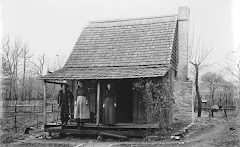Who the very first white settler was is unknown to me. The Wehunt and Chaney families were living on the upper Big Fork before 1852. Big Fork used to be part of Montgomery County. Thomas Jefferson Bates, known as "Uncle Tom Bates", said that the line was changed sometime after the Bates family arrived. A timeline for Montgomery County found at rootsweb.ancestry.com says the line was changed in 1850. It had previously run halfway between Big Fork and Board Camp but was moved six miles east. In 1859 the county line between Polk and Montgomery was defined. In the 1850 census record for Montgomery County, Caddo Township, there are some interesting families such as the Cablers, Chenys, Huddlestons from Tennessee (Margaret Bates, daughter of George V. Bates, married a Huddleston); Seaborn Shed and family from South Carolina and Georgia; Weehunts from North Carolina. There is also John and Polly Rider who were born in South Carolina and had no children in 1850. Samuel and Jemima Rider from Georgia. (Thomas Jefferson Bates, son of Stephen and Sarah Bates, married Dicey Rider and came to Big Fork in 1851.) John Jeffry, born in Alabama, and his wife, Harriet, born in Georgia, with first child being born in Arkansas in 1844. The Fleming family from Georgia also listed.
In 1851, a wagon train from Georgia, brought the Goss, Dilbeck, Kinsie, Garmon, and Ayres families (all being related to each other) and perhaps other families too.
In 1852, the Bates, Abernathy, Vandiver, Walker and Ellison families came from Georgia with ox-drawn wagons. George V. Bates bought 120 acres along the Butcherknife Creek from a Mr. Cabler. Mr. Cabler is thought to be Thomas H. Cabler who was born around 1829 in Tennessee. He married Perline C. Fleming in 1851 in Montgomery County. The Cablers divorced in 1855 and had no children. The reason Mr. Cabler sold his land was because his wife had left him and he had no more use for it.
A very old article called, "Early Days in Big Fork Community", mentions some names. The author is unknown. I received this article from a cousin who worked for years on the Bates genealogy. According to this article, C.B.R. Smith and a Mr. Goss, both from Georgia, settled on Mill Creek. And also an "Uncle Billy Crawford" lived on Mill Creek. Now Mill Creek was over a mountain, west of Big Fork, and later became a community of its own.
William Riley Smith and his wife, Malinda Jane (Turner), and their children came to Big Fork about 1866. They were from Lumpkin County, Georgia. Her sister, Lucretia (Turner), was married to Elijah B. Goss, who had already migrated to Big Fork in 1851.
A large Edwards family arrived in the Big Fork area, from Cherokee County, Georgia, sometime around 1866. This is my estimation based on marriage records. The Standridges came from Rome, Georgia in 1889. Other families from Northern Georgia who settled in the Big Fork area were the Bowens and Stovers.
Of course there were native Americans who lived around the Big Fork area long before white settlers. One of the main tribes that roamed this part of the Ouachita Mountains were the Caddos. The Osage tribe lived mainly north, closer to the Fort Smith area. And the Quapaw Indians lived east of the Caddos and Osage. These tribes intermingled at times. They left many tokens of their existance in the flint arrowheads and stone artifacts that show up in the plowed fields and gardens after a rain.
Saturday, March 27, 2010
Subscribe to:
Post Comments (Atom)



The James Standridge family from Habersham/White County GA was in Montgomery County AR at least by 10/10/1856, the date on three land patents. He sold land to Francis M. Bowen, husband of Temperance M. Standridge, on 2 May 1857. The 1860 census shows this Standridge family in Big Fork Township. 7-year-old Martha & all the older children were born in Georgia, and the two youngest children, William, aged 3 and the infant Dicey, were born in Arkansas. The oldest Bowen child was born 1 Feb. 1855 in GA.
ReplyDelete